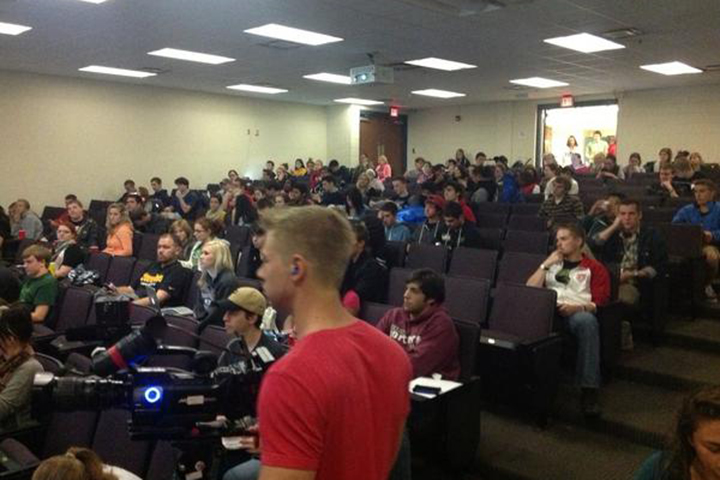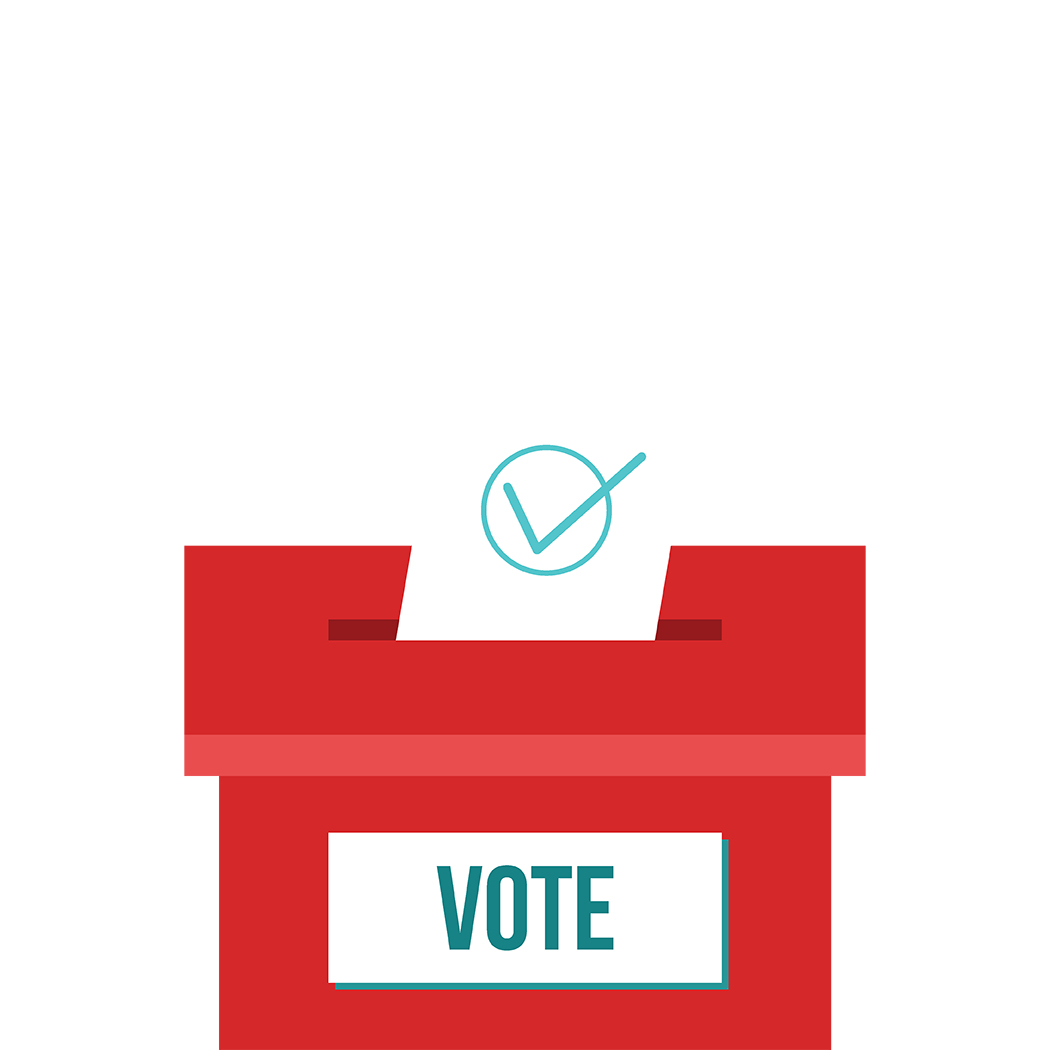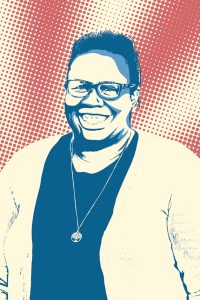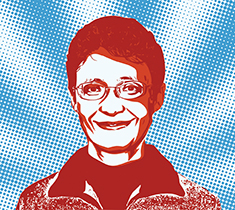Students navigating the voting process in the run-up to the midterm elections have an ally at Illinois State University. The American Democracy Project’s Political Engagement Project has once again marshaled resources to make it easier for students to register to vote and to cast their ballots on campus. The program has also held public events and created the Redbird Voter Guide to encourage students to become better-informed citizens.
The American Democracy Project (ADP) is a national initiative started in 2003 by The New York Times and the American Association of State Colleges and Universities (AASCU) with the goal of increasing civic engagement among students. Illinois State has become a leading institution within the ADP network. In 2006 Illinois State was one of eight universities selected as model political engagement institutions and later became the first university to receive the national Program of Excellence Award for Political Engagement.
ADP’s Political Engagement Project (PEP) is a related project meant to motivate students to be problem-solvers and participate in political action. Both groups collaborate with on-campus partners like the Center for Community Engagement and Service Learning and off-campus groups such as the Illinois Public Interest Research Group.
PEP has collaborated with the McLean County Clerk’s Office to bring a polling place to the Bone Student Center and offers student access to TurboVote, an online voter registration software.
The group’s efforts are paying off. From 2012 to 2016, student voter registration and voting rates increased by 10 percent and 15 percent, respectively. And last primary election saw even more dramatic increases as 677 students voted at the on-campus polling place compared with only 14 during the 2014 primary.
Last spring, Redbird Impact Editor-in-Chief Kevin Bersett discussed the University’s political engagement efforts with ADP Faculty Co-Leader Noha Shawki, associate professor in the Department of Politics and Government, and PEP coordinators Katie Pratt, communication specialist in University College, and Olivia Butts, instructional assistant professor in the School of Kinesiology and Recreation. The Q&A has been edited for brevity and clarity.
What do you view as the main role of the American Democracy Project on campus?
Pratt: I think the biggest role is bringing civic engagement to students and having them be really engaged with what they are doing and how it impacts them.
Our biggest goal with the Political Engagement Project is getting out the vote. Along with the work with ADP has done for years, the Political Engagement Project is trying to show students they should care about elections and should be engaged with the political process.
Shawki: Basically, if I have to summarize the role of ADP on campus in just one sentence, it would be to foster a sense of as a lifelong responsibility among our students.
What are your roles with the ADP, Katie and Olivia?
Pratt: Olivia and I both jumped in last fall because of our involvement on campus and off campus. There are no set roles in PEP. Olivia and I both work on the marketing, outreach, and planning for PEP. We were getting prepared for the spring election and now we are getting set for what we will be doing for the fall. We’re considering what other connections can we make with students and the Center for Community Engagement and Service Learning to make sure students are registered to vote and engage. Our biggest focus is registration and getting students out to vote.
What were some of the things you did to get ready for the primary?
Butts: We contacted a lot of different politically affiliated student groups and talked to them about the importance of reaching their bases to try to get out the vote. We hosted a nonpartisan “get out the vote” event with some other community organizations including the League of Women Voters, the YWCA, and the Bloomington-Normal NAACP.
Pratt: We also did what had been done in the past. We didn’t want to reinvent the wheel in the time frame that we had. We used postcards we could share with students in different capacities. With the website that we have, the voter guide, we updated that too to include more information.
Shawki: That is very much in line with what has been done in the past. In 2016 we worked with the McLean County Clerk’s Office to make sure we had an on-campus polling place. We also had several locations for early voting on campus to make it as convenient as possible for students. We had door decs and postcard-size handouts that were prepared with the all of the key dates, like the voter registration deadline and the dates for early voting, and the kinds of IDs, the number of IDs you need to register to voter.
We also tried to disseminate (information) widely across campus, just using social media and email. For example, President (Larry) Dietz’s office has been really helpful about sending campuswide emails reminding students there is an option to vote on campus. And to remind them that this is something that ISU supports and is committed to because civic engagement is one of the core values of the University.
ADP is strictly nonpartisan. Our goal is to promote civic engagement among students on a nonpartisan basis.
What have you learned from your efforts?
Shawki: Involving all stakeholders is really important—the President’s Office, Housing, the Center for Community Engagement and Service Learning, ADP, student groups.
We collaborated, for example, in 2016 with Milner Library. The first thing you saw when you woke up a computer at the library—their welcome screens—during the voter registration period had information on TurboVote, which is the software we encourage students to use to register to vote.
The SGA (Student Government Association) has a student engagement committee, and they can be really important partners. It really takes participation from a variety of different stakeholders and campus groups to make voter registration and engagement happen on our campus.
Can you give examples of working with different student groups?
Butts: Of course we work with College Republicans and College Democrats, but examples of other organizations we work with include the Student Environmental Action Coalition, Young Americans for Freedom, and a new group called Minority Students for Political Change. We want to make sure they are prepared to register their people through TurboVote and invite them to participate in events that we are hosting, like the “State of Democracy” event.
Tell me about your voter guide. What was in that and where can people find that?
Pratt: It’s located at IllinoisState.edu/Vote. It’s something we have had out there for some time now. We just updated it for the spring election. What we did add was where to vote and what you need to do in order to vote. Everything we did with our marketing was directing students to that website.
Then, we broke it down even more: Who are you voting for? For the presidential election, everyone is amped up and excited about that, but for most local elections and primaries, they are like, “I don’t really know who is running.” So we want to show them this is who will be on their ballot. My goal for the fall is to break that down even further. Here is the ballot. This is what this role does. They may not know what the township supervisor is or what that means to them. But being able to break down every single role is a goal to show why this impacts you as a student at ISU.
What are some barriers stopping students from voting?
Butts: I hear a ton of students say, “Oh, I’m registered back home” or “I don’t want to change my registration.” But I think part of being engaged and being part of a community, that civic engagement piece—you are going to live here for four, maybe five years, so this is your and you should be engaged and you should be interested in making a difference in this community.
A lot of policies and things that happen locally affect these students even if they don’t know it or even if they don’t vote. I once heard, and I tend to share this with my students, that if everyone who lived in Watterson Towers voted, they could choose whoever they wanted to be mayor because nearly more people live in Watterson Towers than people who vote in the mayoral and town council elections. That is a lot of untapped power that the students don’t even realize that they have.
What is ADP and PEP doing to engage students beyond voting?
Shawki: One of them was the event on April 16, the “State of Democracy.” For that event we invited elected officials, at the state and local levels, for a public discussion. That is one way to engage students and get them to think about some of the big issues that we have to wrestle with politically.
We sometimes also have for presidential years debate watch parties. That’s another way we can engage students. Back in 2014, we had a live debate here at the Bone Student Center between the two candidates for Congress in the 13th District, Rodney Davis, who is still incumbent, and Ann Callis.
We always have a speaker for Constitution Day in September. Last year we hosted Carl Hulse, the chief Washington correspondent with The New York Times. He spoke about the role of press freedom in a democracy. Two years ago, in 2016, we hosted a professor at the University of Illinois law school. She spoke about how to balance religious freedom with the rights of the LGBTQ community. That is another way to engage students.
So we have a variety of different programs. We have events and speakers throughout the year and some events focus on global engagement and fostering a sense of global citizenship.
Looking at the statistics from 2012 to 2016, there were dramatic increases in voter participation on campus. What led to the increase?
Shawki: There was a big jump. We, of course, intensified our efforts between 2012 and 2016. We’ve been trying to do more and more, but I think the 2016 election itself, mobilized a lot of voters. So it’s hard to tell what part of that increase is part of our work and what part of it is just a reflection of the political realities of that election.
What are you doing for the fall election?
Pratt: One of the ideas that we had talked about for the spring and we just didn’t have time to do it but we’ll make sure to get done for the fall is a fair, something that brings together candidates with students and interest groups who students would be interested in getting involved with. You can go talk to (State Rep.) Dan Brady, for example. You can go and talk to this person and get some literature and be engaged with what the issues are. I think that is going to be the best way to have students be engaged with the candidates.
I think it would be so great to have more faculty involvement in this in their classrooms to really hone in on civic engagement being an important piece of ISU’s values. Finding unique ways for them to bring the civic engagement piece in some capacity within their discipline and in their class to really get students thinking about their involvement outside of just students saying, “Oh, I’m going
to go vote on one day.”
Kevin Bersett can be reached at kdberse@IllinoisState.edu.





